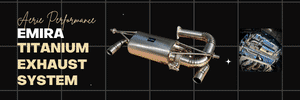GrahamClark_60-68
Emira Fanatic
Ok, to preface this noob of the century question I recall the following saying “Better to stay silent and be thought the fool than to speak and remove all doubt.” But after much thought and many Google searches that have come up naught, I’m throwing caution to the wind here.
On weight distribution of the Emira V6 wrt other mid engine cars I understand that the engine positioning which is pretty much over the rear axle rather than more forward of the rear axle puts the car more in the category of “mid-rear” engine rather than “true” mid engine. A quick glance at the specs of the Espirit V8 and Ferrari 308 as a comparison surprisingly (at least to me) shows only slightly more mid bias (2-3%) than the Emira, I’m guessing attributed to the lighter power plant on the Emira. And I do appreciate the extra space I get behind the seats as a result as opposed to these other cars with the seats right up against the firewall.
But…. I’ve always been baffled by the left to right bias of the engine on the Evora and Emira (biased to the right looking from rear of the car). If I didn’t know its origins were British I could chalk it up to the driver being on the left and no passenger (i.e., better balance on the track and for solo driving). But of course for those of you driving on the wrong side of the car and road that would be double trouble (driver and engine on the same side of the car).
I also thought that maybe I was just looking at the supercharger cover and maybe it was offset to the right somehow and the engine itself was actually centered left to right but in the many assembly pictures I’ve seen that doesn’t seem to be the case and it does appear the engine itself is more to the right of the car.
So with this said, yes I’m out of ideas. Can someone help me out with my insanity?
On weight distribution of the Emira V6 wrt other mid engine cars I understand that the engine positioning which is pretty much over the rear axle rather than more forward of the rear axle puts the car more in the category of “mid-rear” engine rather than “true” mid engine. A quick glance at the specs of the Espirit V8 and Ferrari 308 as a comparison surprisingly (at least to me) shows only slightly more mid bias (2-3%) than the Emira, I’m guessing attributed to the lighter power plant on the Emira. And I do appreciate the extra space I get behind the seats as a result as opposed to these other cars with the seats right up against the firewall.
But…. I’ve always been baffled by the left to right bias of the engine on the Evora and Emira (biased to the right looking from rear of the car). If I didn’t know its origins were British I could chalk it up to the driver being on the left and no passenger (i.e., better balance on the track and for solo driving). But of course for those of you driving on the wrong side of the car and road that would be double trouble (driver and engine on the same side of the car).
I also thought that maybe I was just looking at the supercharger cover and maybe it was offset to the right somehow and the engine itself was actually centered left to right but in the many assembly pictures I’ve seen that doesn’t seem to be the case and it does appear the engine itself is more to the right of the car.
So with this said, yes I’m out of ideas. Can someone help me out with my insanity?









